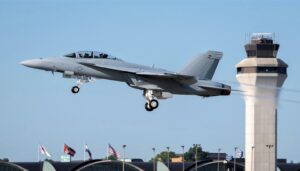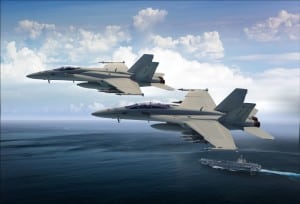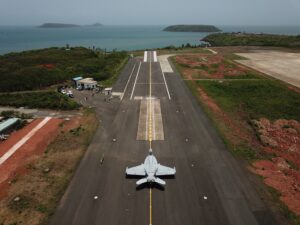Boeing [BA] said on Thursday it plans to finish building new F/A-18 E/F Super Hornet naval fighter aircraft in late 2025 as Navy orders are expected to end, barring a potential decision by India to order the aircraft that would extend the work by two more years.
Congress last funded 12 Super Hornets for $977 million in the FY ‘22 spending package (
Defense Daily, March 9, 2022).
The Navy’s FY ‘23 budget request documents confirmed the service sought to end the production line and not procure any more Super Hornets after the FY 2022 order.

Boeing argued this decision allows the company to redirect resources to future military aircraft programs, particularly work on the next generation of advanced crewed and uncrewed aircraft.
The Navy has revealed few details of its 6th generation Next Generation Air Dominance (NGAD) concept that will succeed the Super Hornets beyond saying it will include a mix of manned (F/A-XX) and unmanned aircraft. The Navy NGAD effort budget has been classified since 2020.
Boeing said while Super Hornet production focused in St. Louis ramps down it plans to invest about $1 billion to build three new facilities at its St. Louis, Mo., location along with a new Advanced Composite Fabrication Center in Arizona and a new MQ-25 Stingray unmanned carrier-based refueling aircraft production facility at the MidAmerica St. Louis Airport.
The unmanned MQ-25 aims to free up Super Hornets currently assigned to the refueling role on aircraft carriers, allowing more of them to perform their original mission.
The company boasted it has poured $700 million into St. Louis facilities infrastructure upgrades over the past 10 years to aid introducing new designs, build techniques, streamlining processes and improve first-time quality.
It also plans to ramp up production of its T-7A Red Hawk Air Force trainer aircraft, the MQ-25, and continue ongoing production on the new Air Force F-15EX Eagle IIs and 777X commercial airline wing components
Boeing underscored it will still continue modernization and upgrade efforts on the global Super Hornet and EA-18G Growler electronic warfare aircraft fleets.
“Throughout the next decade, all Block II Super Hornets in Service Life Modification (SLM) will receive the Block III capability suite. Boeing will also continue to add advanced electronic attack capability as part of ongoing Growler modifications,” the company said.
The SLM effort entails Boeing taking Super Hornets near the end of their initial 6,000 flight hour service lives and upgrading them to the new Block III configuration, with a primary focus on increasing lifespan to 10,000 hours total. It is divided into two increments, increasing flight hours first to 7,500 hours, then later boosting it to 10,000 flight hours.
Other Block III improvements include a reduced radar signature and upgrades to the Block II Infrared Search and Track System sensor and Active Electronically Scanned Array (AESA) radar.
Boeing currently has three SLM work lines in its facilities in St. Louis, San Antonio, Texas and the Navy’s Fleet Readiness Center Southwest on Naval Air Station North Island, Calif. The last location was stood up as of last summer (Defense Daily, July 14, 2022).
In July, Rear Adm. Andrew Loiselle, the director of the Air Warfare Division, N98, said the 10,000 flight hour boost is expected to provide the Navy with 12 to 13 years of utilization out of each airframe.

In 2019, Boeing said it initially took 18 months to perform the first increment of SLM upgrades, but it expected that to lower to 12 months each as the work line and system improves. The company said it plans to modify up to 40 Super Hornets per year, at the SLM peak (Defense Daily, May 7, 2019).
Last year, Loiselle said while Boeing says it now takes 12 months to complete each SLM phase, the Navy alloted 15 months to be more conservative in its planning (Defense Daily, April 29, 2022).
Boeing also highlighted that if the Indian Navy selects the Block III Super Hornet for its future fighter effort, Super Hornet production could be extended to 2027.
India requires the aircraft to operate with a short takeoff by arrested recovery (STOBAR) system used in its aircraft carriers the INS Vikramaditya, formerly the Soviet Admiral Gorshkov, and its first indigenous carrier INS Vikrant.
India previously bought 45 Russian Mikoyan MiG-29Ks to operate on the Vikramaditya and is looking to acquire another 26 multi-role fighters for both carriers and is due to decide this year between the Super Hornet and the French Dassault Rafale fighter jet. The government previously agreed to buy 36 Rafales for the Indian Air Force in 2016
The company first tried to prove the Super Hornet can operate on an Indian aircraft carrier short takeoff by arrested recovery (STOBAR) system with a ski jump test in 2020 (Defense Daily, Dec. 22, 2020).

Then, last year, two Navy Super Hornets conducted several ski-jumps, roll-in and fly-in arrestments, and performance flights in several weight configurations at Indian Naval Station Hansa in Goa, India. The Rafale also proved it can operate in a ski jump configuration. (Defense Daily, July 22, 2022).
However, recent reports in Indian media indicate the government is learning toward the Rafale because it meets more of the government’s requirements.
Boeing previously lost the chance to sell at least 18 Super Hornets to Canada as that country was looking to replace its aging CF-18 Hornets due to a commercial trade dispute.
In 2017, Canada initially planned to buy 18 Super Hornets to replace some of the legacy Hornet fleet before a longer term fleet transition later. However, after Boeing initiated a trade challenge against Canada’s Bombardier over complaints it sold a commercial airliner at an artificially low price, the government reacted by instead replacing the CF-18s with 18 used Australian F/A-18 Hornets (Defense Daily, Dec. 12, 2017).
Last month, Canada finalized a deal to buy 88 Lockheed Martin [LMT] F-35As to ultimately replace its fleet of 76 CF-18s (Defense Daily, Jan. 9).
That came after Canada also rejected Boeing’s Super Hornet bid as a finalist for the Canadian fighter jet competition in late 2021, with the F-35 and Sweden’s Saab Gripen E as the finalists (Defense Daily, Dec. 2, 2021).
Boeing noted it has delivered more than 2,000 total Hornets, Super Hornets and Growlers in several configurations globally since 1983. Customers include the U.S. Navy, Australia, Canada, Finland, Kuwait, Malaysia, Spain and Switzerland.